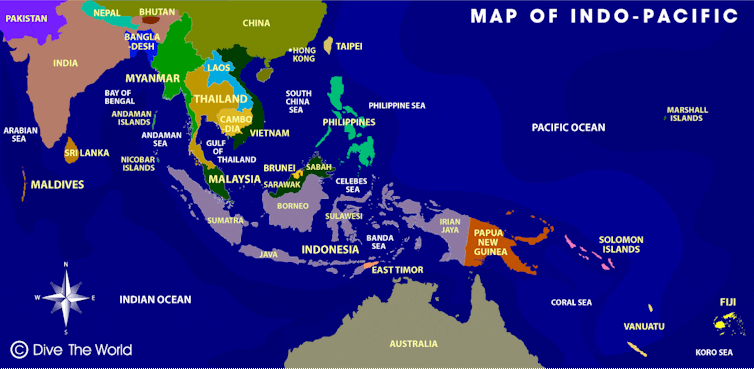Just in case you hadn’t heard, Perth is now officially the centre of the universe – or the geopolitical universe, at least. This comes as no surprise to those of us who actually live there, of course, but it’s good to have this idea endorsed by luminaries in the foreign policy establishment.
The reason Western Australia has assumed such unaccustomed prominence in the minds of policymakers here and in the US is because it’s right in the middle of the so-called ‘Indo-Pacific’. There’s a good chance that many Conversation readers will actually have heard of this concept, but there’s an even greater chance that most of the general public won’t.

Given that foreign policy is a fairly esoteric interest at the best of times, this is unsurprising, perhaps. And yet there’s a good deal at stake in the way policymakers think about and act upon the world. If we call our neighbourhood the ‘Asia-Pacific’, for example, this implies a very different set of actors and interests than say, ‘East Asia’. The key difference for Australia is that not only is it in the Asia-Pacific, but so, too, is its principal strategic partner, the United States.
Such underlying geopolitical realities help to explain why Australian diplomats have been such enthusiastic champions of the Asia-Pacific idea: it held out the promise of delivering crucial strategic and economic outcomes. The fact that it has been something of a disappointment is a reminder that translating ideas into action requires the active participation of notional members.
The underwhelming performance of APEC – the key institutional expression of the Asia-Pacific idea – is testimony to the enduring gap between rhetoric and reality.
Given this checkered history of institution-building and regional leadership, the enthusiasm for the Indo-Pacific is rather surprising. On the face of it, the Indo-Pacific looks a much harder sell than the Asia-Pacific, which at least had the merit of having been an established part of the policymaking discourse for years. The Indo-Pacific is a much more recent invention that has been driven – like so much else in our neighborhood – by the rise of China.
The Indo-Pacific is thought to stretch from the western part of the Indian Ocean to the eastern part of the Pacific, also taking in north and southeast Asia as well as Australia. The potential importance to Australia of this putative region is plain, and its merits have been enthusiastically spruiked by West Australian foreign ministers from both major parties (Stephen Smith and Julie Bishop).
But no matter how enthused Australian policymakers may be, it would matter little unless the United States thought there was something in it too. Fortunately for the Indo-Pacific’s energetic champions, they do.
In the great geopolitical contest between the US and China, the Indo-Pacific offers yet another way of responding to China’s rise. It may not be called containment, but the idea that an increasingly powerful India might provide another important counter-weight to balance China’s growing influence is plainly attractive for many grand strategists in the US and Australia.
But even if this is a sensible response to China’s rise – and many think it isn’t – a more fundamental question is whether it’s actually feasible. Nick Bisley and Andrew Phillips are two of the most astute Australian observers of regional security and they argue that:
Any serious attempt to operationalise an Indo-Pacific US grand strategy would incur costs, commitments and risks that would undermine rather than strengthen Washington’s ability to maintain order in Asia.
It is, in short, a ‘recipe for over-extension’, they argue. At a time when the US is struggling to convince its allies in the Asia-Pacific that it still has the capacity and – more importantly, perhaps – the will to underwrite its existing security commitments and alliance obligations, it is hard to see how it can credibly take on significantly expanded commitments elsewhere.
This may not be the disaster some in Australia, especially in its far flung invariably neglected western reaches, imagine. On the contrary, traditional forms of balancing China’s rise have done little to influence its behavior so far. American troops in Darwin or even a permanent US naval presence at Garden Island south of Perth would do nothing to change this – other than to further irritate the Chinese.
If the idea of the Indo-Pacific is to amount to something other than a new rationale for deploying military forces and forging new alliances, then it might be worth thinking about its possible institutional potential instead. It does, after all, contain all the region’s strategic heavyweights and could provide a basis for negotiating a way through inexorable long-term geopolitical and geoeconomic shifts.
Finding some mechanism to accommodate the relative shift in standing of the US and China is the key challenge for the region – however it is defined. No-one has a bigger stake in this than Australia. Providing a bit of creative middle power diplomacy of the sort that is much discussed but rarely seen, might one way of really putting the Indo-Pacific on the map.
